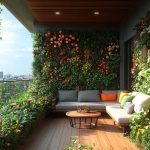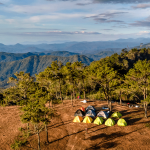
Introduction
In the vibrant hum of urban life, the soft whispers of nature may seem distant. Yet, for eco-conscious city dwellers, staying connected with nature is more than a desire—it’s a necessity. This intrinsic connection, known as biophilia, highlights our innate affinity for natural environments. This blog explores how urbanites can weave nature into their lives, even amidst towering skyscrapers and bustling streets. By understanding the challenges and exploring creative solutions, you can nurture your connection with nature and enjoy its myriad benefits.
Challenges of Staying Connected to Nature in Urban Environments
Urban environments present a unique set of challenges to maintaining a connection with nature. The most visible barrier is the sheer dominance of concrete and steel infrastructure, which often leaves little room for natural landscapes. Urban sprawl tends to prioritize development over green spaces, reducing access to parks and natural areas. This scarcity can make it difficult for city dwellers to find tranquil spots to recharge amidst the chaos.
Another challenge is the fast-paced lifestyle that urban living demands. Many city residents are caught in a constant cycle of work and social commitments, leaving little time for leisurely nature excursions. The hustle and bustle of city life can detract from one’s ability to focus on and appreciate the subtle beauty of the natural world. Consequently, reconnecting with nature may slide down the list of priorities for busy urbanites.
Lastly, air and noise pollution can further hinder the ability to enjoy nature within city limits. The pervasive sounds of traffic and industrial activities can drown out the calming sounds of birdsong or rustling leaves. Similarly, poor air quality can diminish the health benefits derived from outdoor activities. Overcoming these challenges requires a conscious effort to incorporate elements of nature into everyday urban life.
Benefits of Connecting with Nature
Spending time in nature offers numerous physical, mental, and emotional benefits. On a physical level, exposure to natural environments has been shown to boost immune function, reduce blood pressure, and increase overall well-being. The act of walking or jogging in a park not only provides exercise but also replenishes energy and revitalizes the senses.
Mentally, nature can serve as a powerful antidote to the stressors of modern urban life. Studies suggest that time spent in green spaces reduces stress, anxiety, and depression. The tranquility of nature encourages mindfulness and helps to quiet the mind, leading to improved concentration and cognitive function. Integrating a touch of green into daily routines can profoundly impact mental clarity and productivity.
Emotionally, nature fosters a sense of connection and belonging. It reminds us of the beauty and wonder inherent in the world, instilling a sense of gratitude and contentment. Nature’s restorative qualities can uplift moods, enhance creativity, and promote a positive outlook on life. For city dwellers, these emotional benefits are invaluable in cultivating a balanced and fulfilling existence.
Strategies for Incorporating Nature into Daily Urban Life
Integrating nature into daily urban life can be achieved through various creative strategies. One simple yet impactful approach is to add greenery to living spaces. Indoor plants, such as succulents or ferns, bring a touch of nature indoors and improve air quality. Additionally, creating a small balcony or window garden allows urban dwellers to cultivate their green oasis and enjoy the soothing presence of plants.
Seeking out urban parks and green spaces is another practical way to stay connected with nature. Many cities offer hidden gems, such as community parks, botanical gardens, and waterfront promenades. Regular visits to these natural retreats provide opportunities for relaxation and recreation. Whether it’s a leisurely stroll, a picnic with friends, or quiet meditation, urban parks offer a refreshing escape from the city’s chaos.
Engaging in eco-friendly activities can further deepen the bond with nature. Consider participating in local green initiatives, such as volunteering for tree planting events or joining community clean-up efforts. Exploring sustainable transportation options, like biking or walking, not only reduces your carbon footprint but also allows you to enjoy the beauty of your urban surroundings at a leisurely pace.
Technology’s Role in Reconnecting with Nature
While technology is often seen as a barrier to nature experiences, it can also be leveraged to enhance our connection with the natural world. Mobile apps and online platforms offer innovative ways to explore, learn about, and appreciate nature, even in urban settings. For example, nature guide apps provide information on local flora and fauna, transforming a walk in the park into an educational adventure.
Virtual reality (VR) and augmented reality (AR) technologies can bring immersive nature experiences to urban dwellers. Through VR headsets, users can virtually explore lush forests, serene beaches, or majestic mountains without leaving their homes. AR apps allow individuals to superimpose digital images of animals and plants into their surroundings, creating interactive and engaging nature encounters.
Social media platforms also play a role in fostering a sense of community and shared appreciation for nature. By following nature-focused accounts and hashtags, urban residents can connect with like-minded individuals, discover new green spaces, and gain inspiration for incorporating nature into their lives. Technology, when used mindfully, can bridge the gap between urban living and a profound connection with the natural world.
Community Engagement and Advocacy
Community engagement and advocacy are essential components of bringing nature closer to urban residents. Community gardens, for instance, offer shared spaces where individuals can come together to cultivate plants and vegetables. These gardens foster a sense of community and provide opportunities for learning and collaboration. They also serve as vital green spaces within urban neighborhoods, promoting biodiversity and sustainability.
Urban reforestation projects are another impactful way to reconnect with nature. Planting trees in urban areas not only enhances the aesthetic appeal of neighborhoods but also improves air quality and provides shade. By participating in tree-planting initiatives, residents can actively contribute to the greening of their cities and create a healthier environment for themselves and future generations.
Advocacy for green policies and initiatives is crucial for ensuring access to nature in urban environments. Supporting organizations that promote sustainable urban planning, protect natural habitats, and advocate for the creation of new parks can lead to increased opportunities for residents to enjoy nature. By raising awareness and actively participating in community efforts, individuals can drive change and make a lasting impact.
Case Studies and Personal Stories
Real-life examples and personal stories illustrate the positive impact of integrating nature into urban lifestyles. In the heart of bustling New York City, the High Line stands as a testament to the power of urban green spaces. This elevated park, built on a former railway line, offers a serene escape amidst the cityscape. Visitors can stroll along the lush pathways, surrounded by native plants and stunning views of the city skyline.
In Tokyo, the Shinjuku Gyoen National Garden provides a tranquil oasis in one of the world’s busiest cities. This expansive garden features meticulously manicured landscapes, cherry blossom trees, and serene ponds. It serves as a place of respite for both locals and tourists, offering a peaceful retreat from the city’s hustle and bustle.
On a personal level, individuals like Emily, a resident of Melbourne, have embraced nature within their urban environments. Emily transformed her small apartment balcony into a thriving garden filled with herbs, flowers, and even a small vegetable patch. This green sanctuary provides her with a sense of tranquility and joy, allowing her to connect with nature daily.
Conclusion
In a world that often seems disconnected from nature, urban dwellers have the power to bridge the gap and nurture their connection with the natural world. By understanding the challenges and benefits of staying connected to nature, exploring creative strategies, leveraging technology, engaging with community initiatives, and drawing inspiration from real-life examples, individuals can create a harmonious balance between urban living and a love for nature.
Whether it’s adding a touch of greenery to living spaces, seeking out urban parks, or participating in community gardens, there are countless ways to bring nature into daily urban life. By doing so, individuals can reap the physical, mental, and emotional benefits that nature provides, fostering personal well-being and contributing to a healthier planet.
Take that first step today and explore the suggested strategies. Make nature an integral part of your urban lifestyle and experience the profound joy and fulfillment that comes from staying connected to the natural world. Together, let’s create greener and more sustainable cities for ourselves and future generations.





